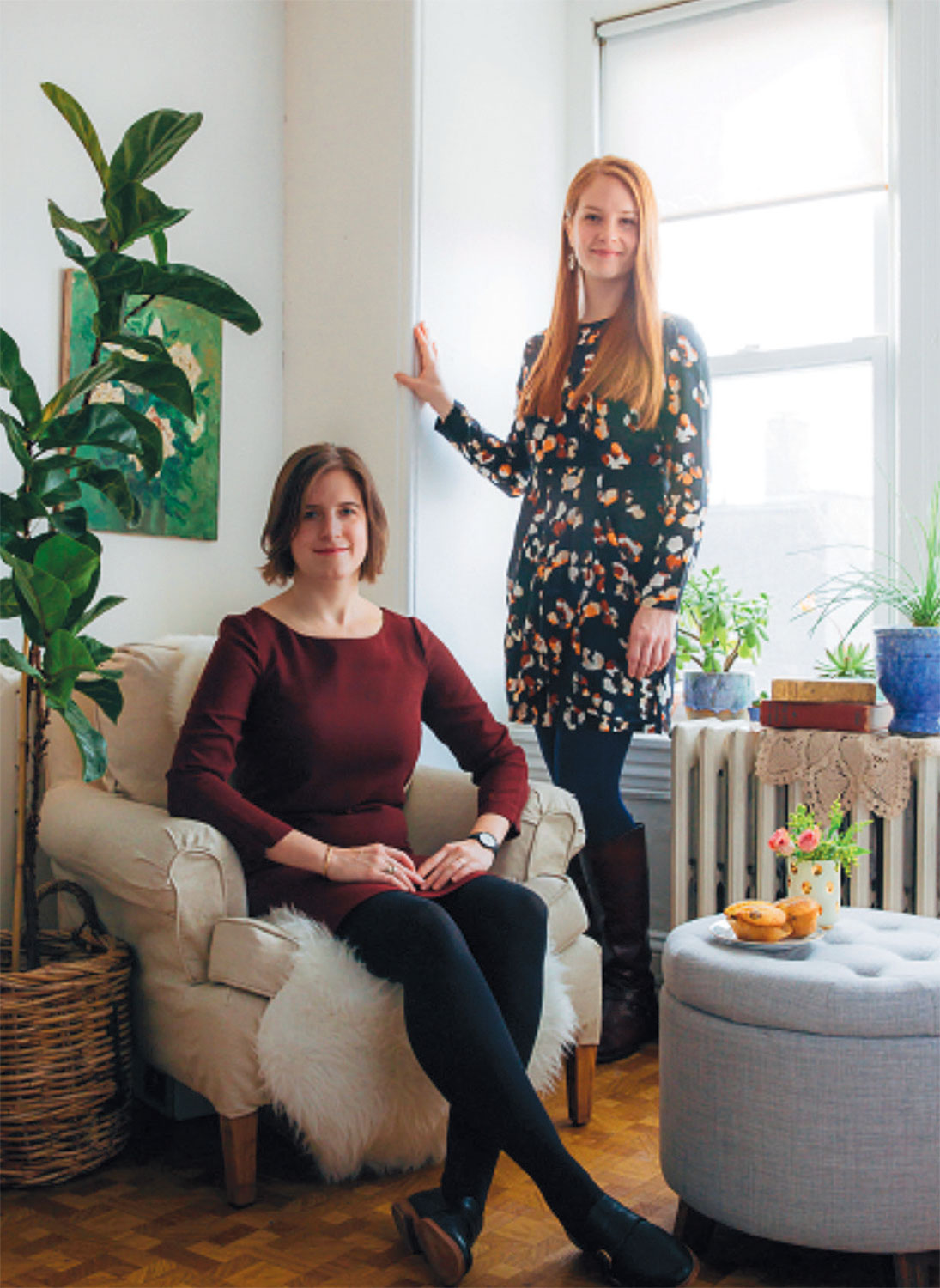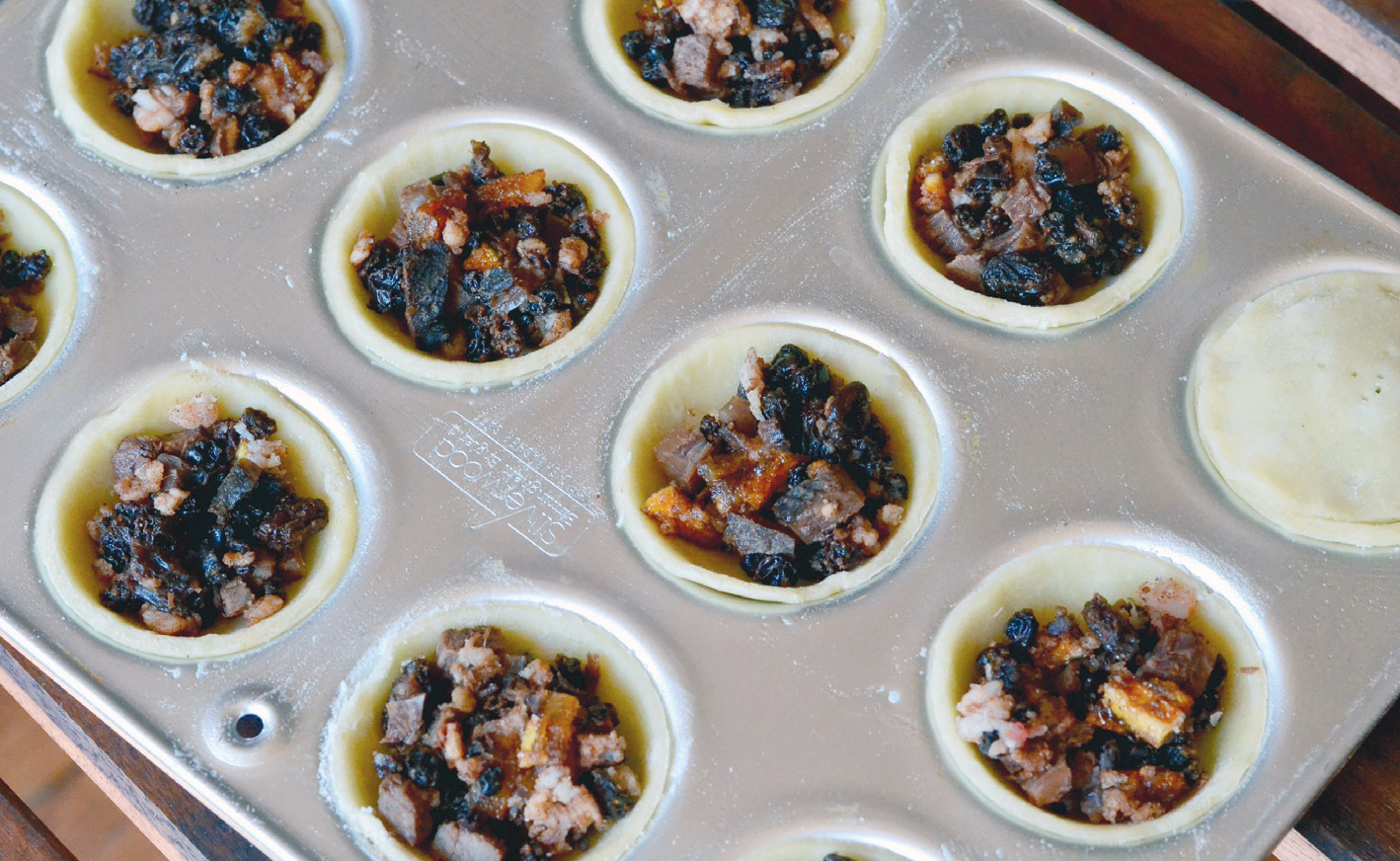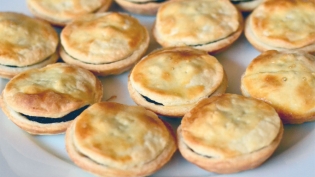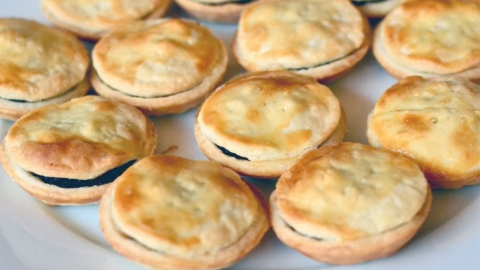Mince Piyes My Mothers Way
Holiday cooking in the archives

Imagine that Deb Perelman of Smitten Kitchen—a chatty, personal recipe blog that celebrates unfussy food—came into possession of a time machine. Then pretend she had a penchant for early-modern British cooking. In that alternate world, her website might read quite like Cooking in the Archives, a Philly-based website that revives dishes from 1600 to 1800, one recipe at a time. Intimidating culinary techniques that have faded or been forgotten are reborn and rendered tangible for a 21st-century audience. A door to the past is opened, and preparations like “solid sillibubs,” a sweetened dessert of cream and wine, or “pease pods of puff paste” find new life.
Born in a West Philadelphia kitchen, the project is helmed not by chefs but by two avid home cooks and University of Pennsylvania English scholars: Alyssa Connell and Marissa Nicosia.
Their confection was originally born of an academic research need: a drive to master paleography, or the reading of historical handwriting. While completing their respective dissertations in early-modern English literature, the pair needed a passageway into archival material. Documents from the period, which spans roughly from the mid-sixteenth century to the dawn of the nineteenth, feature now-unfamiliar hands and a “Wild West” of spelling, as Nicosia puts it. This makes them largely inscrutable to all but the specially trained.
As luck would have it, the University of Pennsylvania’s Kislak Center for Special Collections, Rare Books and Manuscripts had recently digitized and made public a trove of women’s early-modern cookbook manuscripts. Recipes, it turns out, are commonly used in paleography workshops. When the pair came across the University of Pennsylvania’s GAPSA-Provost Fellowship for Interdisciplinary Innovation, lightning struck: why not launch a public-history culinary project that would accelerate the pair’s early-modern reading skills while making archival recipes accessible to those curious about the “macarony cheese” of yesteryear? (Nicosia will tell you: it is delicious.)
Cooking in the Archives, also known as rarecooking.com, launched in summer 2014, and has been gaining steam ever since. Leveraging the Kislak Center’s manuscripts, Connell and Nicosia wield their doctoral English training to translate, test and update historic recipes for today’s kitchens. The project opens a window onto tables past, reviving flavors in the process—and there’s as much to the literal translation as to the translation of technique.
“We’re connecting people to an archive that they can technically access, because they can click on any of these digital images—but they can’t actually access it, because they can’t read the handwriting,” says Nicosia, now an assistant professor of English at Penn State Abington. “It’s not like clicking on Epicurious.”
This is only one challenge. Antique “receipts” also lacked the specifics that we lean on today, like cooking times and temperatures. Any woman worth her salt (or perhaps sugar) was expected to know how to bake. She also would be cooking with fire.
As the website has grown, it has taken on its own life, but a spirit of inclusivity prevails. “We’re trying to be the Smitten Kitchen of historical food,” Nicosia explains. “Accessible. Accurate. Unpretentious.” As we collectively yearn for holiday baked goods in a season defined by sugary excess, that’s a reassuring sentiment. Cooking in the Archives offers much inspiration for those determined to eschew merry monotony in favor of something more interesting.
“When there’s a recipe that tells you to combine
something in a mortar and pestle for three hours?
The lady of the household is not doing that.”
Women in partnership and in authority
One of the most compelling aspects of the project is the view it provides of women’s lives.
As Ken Albala describes in his book Food in Early Modern Europe (Greenwood, 2003), the early-modern period sits between two eras that ushered in seismic culinary changes in the West. “These years, roughly the three centuries between the first European contact with the New World and the Industrial Revolution, have often been described as another Agricultural Revolution,” he writes. New American foods and luxuries from the Eastern spice trade reached European cities, forever altering their cuisine. Agriculture moved from the family to the marketplace, becoming big business.
For the upper classes, coveted ingredients like sugar were a way to showcase one’s clout in the face of shifting social structures and fast-evolving foodways. “To offer guests a heavily spiced dish was literally to consume one’s wealth,” Albala continues. Sugar and fine white flour were much the same. How to use such ingredients was the domain of the lady of the house. Manuscripts were a way to capture her methods and communicate them.
In other words, they were a marker of female pride.
“Some of the households’ records show signs of men as well, both in culinary and medicinal recipes,” Nicosia says. “But more of the manuscripts in the archive are about women.” This reflects a gender divide that may ring familiar to those versed in the dialogue about the food world today. Men wrote published cookbooks, not household manuscripts. They cooked not in the home but in restaurants or inns, ushering in the era of the chef. Women, by contrast, were expected to manage their households with panache—or in the case of the elite, such as those who could afford (or read) these books, to manage those tasked with its management.
“When there’s a recipe that tells you to combine something in a mortar and pestle for three hours? The lady of the household is not doing that,” Nicosia says.
If this sounds top down, it was. “It’s interesting on the one hand to be doing this work which is uncovering the lost histories of women,” Nicosia says. “But on the other hand, this is totally about an elite, global, colonial practice based on systemic exploitation. I never want to talk about it without talking about the other arms of this history.”
Though reliant on her servants, the lady of the house would not have been fully hands-off. Showpieces, such as delicate sugar work, would remain a personal flourish. Yet one of the striking things about the manuscripts is the glimpse of female relationships that can be found between the ornate lines. In one instance, Connell uncovered a gingerbread recipe that contained a note: “Share this with your servant.” This points toward affinity, if not friendship.
Intergenerational marginalia can also be found among books passed between generations. “I like seeing networks of female relationships, women who have written down other women’s recipes and perhaps passed on some of their own,” says Connell, now assistant director of leadership communications at the University of Pennsylvania Museum of Archaeology and Anthropology. “Or, for books that have multiple hands, glimpses of continuity in women’s culinary lives, picking up on and continuing to use something created earlier.”
Tellingly, many books carry few or no identifying details, obscuring the women behind the ornate handwriting. To that end, Nicosia quotes Virginia Woolf: “For centuries, Anonymous was a woman.”

Marissa Nicosia, left and Alyssa Connell, right
One woman’s mince is another’s treasure
Festive meals for the holidays would showcase the prowess of a woman of means, taking days and many hands to prepare. With winter celebrations nigh, an anglophile’s thoughts might turn to mince pie: Nicosia’s own affinity for the sweet-meets-savory treat is something of a holiday romance story.
“I fell in love with mince pies in London on a cold December day,” she writes in a blog entry entitled “To make minceed pies.” “British winters are shockingly raw, wet and dark to an American visitor accustomed to sharp East Coast winds and bright winter light. These sweet, spiced pies warmed me to my core.” All the better that these gateway pies were specially baked by her husband, Joseph.
The master recipe that pairs love and food is time-tested.
In the early-modern period, mince pie may have been part of a midday banquet rich with pageantry. The objective would be to spoil guests with choice, an antique version of the humblebrag. Given that mince relies on ingredients that would have to be imported—sugar, citrus, spices—it’s a perfect example of conspicuous consumption. “It’s about showing your luxury,” Nicosia says. “It’s about saying, ‘I’m rich enough that I have all of this sugar, that I can do this.’”
As guests indulged, red and spiced wines would flow. In family-style buffets, lines between sweet and savory would also cross, as they do in the recipe shared here. It’s an approach that can challenge a American’s assumptions about flavor. Dessert, goes the logic, is the time for sugar. A course with meat? Not so much. In early-modern Britain, as in much of the contemporary world, however, that distinction wasn’t made.
Nicosia has translated two such minces for the project so far. This version comes from Manuscript Codex 252, written in a gorgeous hand with early entries dating back to the early seventeenth century. Dried fruits meet booze in a flaky crust. Slow-braised beef cheek is paired with suet, a hardened beef fat that takes the place of butter. To be clear: it is all the better for it. The union of flavors results in something greater than the sum of parts.
That you can learn something about the past in the process of cooking it is an added bonus.
Nicosia is intuitive in the kitchen, feeling her way through recipe instructions that leave much unsaid. She grates frozen suet by hand until it feels sufficient and looks balanced in the bowl—more than we would use today. It drops like snow atop beef, dried fruit, candied citrus peels and spice. (This is the early-modern equivalent of living large.) A large pie would have been fashionable, but Nicosia opts for mini-pies—and she’s okay with that. She’s more interested in the spirit of the recipe and its potential for actual use than literalism.
This is not to discourage those who might take a black-and-white approach. Connell herself favors precision. On the website, readers are encouraged to share the results of their own experiments, and vibrant discussions emerge.
It is a dynamic Nicosia looks forward to fostering as she incorporates culinary paleography into her work with undergraduate researchers at Penn State Abington. “I’m wondering what that’s going to kick up,” Nicosia says. “Looking at recipes with multiple people, it’s always so interesting how much diversion you have, even in a community of homogenous scholars. When you pull in undergraduate students, it’s even more exciting. They’re going to ask things that you never even thought of because of your disciplinary training.”
In the end, the flavors of Nicosia’s mince pie are balanced, an expression of the hand that made it but also of those that came so many centuries before. It’s not at all too sweet.
COOKING IN THE ARCHIVES
rarecooking.com
instagram.com/rare_cooking
TIPS FOR YOUR TRIP TO THE RECIPE ARCHIVE
As you cook your way through history, especially if you plan to attempt a translation of your own, Nicosia has a few recommendations.
Expect scant information on times or temperatures. Watch the proportions. (A kitchen scale is handy.) Feel free to take the shortcuts that make sense: “If most things require the vigorous whipping of egg whites, I save tons and tons of work by using an electric mixer,” Nicosia says. Also, consider how much you’re making. Documented recipes were often designed for formal banquets. (Not that there’s anything wrong with leftovers of a mince mix this delectable.)
One last point: Be adventurous. “Just because it’s old doesn’t mean it doesn’t work,” Nicosia says. “You can actually access this history. You can access some of these fl avors that are more unfamiliar. You don’t have to be a historian to do it.”
In many ways, this is a key revelation of the project for Connell and Nicosia.
“I’ve always enjoyed fl ipping through older cookbooks, starting with some of my Grammy’s Betty Crocker cookie books,” Connell says. “Now, I feel like I do it and see them as part of a long timeline.”
Give this spin (on opposite page) on mince a try. With guidance from Cooking in the Archives, you can merge the spirit of another age with the spirit of the holidays.







